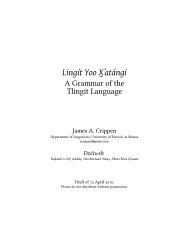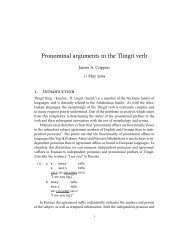A comparison of morphosyntactic features between Marquesan ...
A comparison of morphosyntactic features between Marquesan ...
A comparison of morphosyntactic features between Marquesan ...
You also want an ePaper? Increase the reach of your titles
YUMPU automatically turns print PDFs into web optimized ePapers that Google loves.
. ‘ua pau ‘e-kolu pō<br />
PERF complete NUM-three night<br />
“three days passed”<br />
HAW<br />
Because HAW uses monolexical numbers for the decades below one hundred<br />
(e.g. kanalima “fiy”), and because these forms do not take the numeral classifier<br />
‘e-, the following <strong>comparison</strong> uses ‘elima haneli “five hundred” in the HAW sentence<br />
instead.<br />
(3) a. ‘e ‘ima onohu‘u ‘enana i he‘e<br />
NUM five ten person PAST go<br />
“fiy men went” (Mutu & Teìkitutoua 2002:77)<br />
b. ‘e-lima haneli kanaka i hele<br />
NUM-five hundred person PAST go<br />
“five hundred men went”<br />
MQA<br />
HAW<br />
Lazard & Peltzer (2000:162) do not list any indefinites in their description <strong>of</strong><br />
TAH articles. However, e is given as a cognate <strong>of</strong> HAW he (p. 36ff). eir examples<br />
only give it in initial position, and not in as an article.<br />
(4) a. e manu terā<br />
IND bird MDIST<br />
“that is a bird” (Lazard & Peltzer 2000:36)<br />
b. e fa‘ehau terā ta‘ata<br />
IND soldier MDIST person<br />
“that man is a soldier” (id.)<br />
TAH<br />
TAH<br />
Tryon (1970:10) describes TAH ‘e as an article which has the same “demonstrative<br />
force” as ‘o, which in turn is “a kind <strong>of</strong> demonstrative article, meaning ‘it is’ ”.<br />
His glosses seem to indicate that it functions as an indefinite because he contrasts it<br />
with definite forms glossed for ‘o. As with Lazard & Peltzer (2000), it only appears<br />
in initial position in a manner similar to ‘o.<br />
(5) a. ‘e ta‘ata<br />
IND person<br />
“it is a person” (Tryon 1970:10)<br />
b. ‘o te ta‘ata<br />
EQN DEF person<br />
“it is the man” (id.)<br />
TAH<br />
TAH<br />
4





